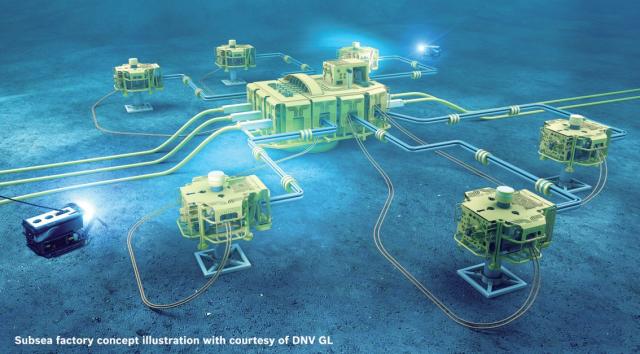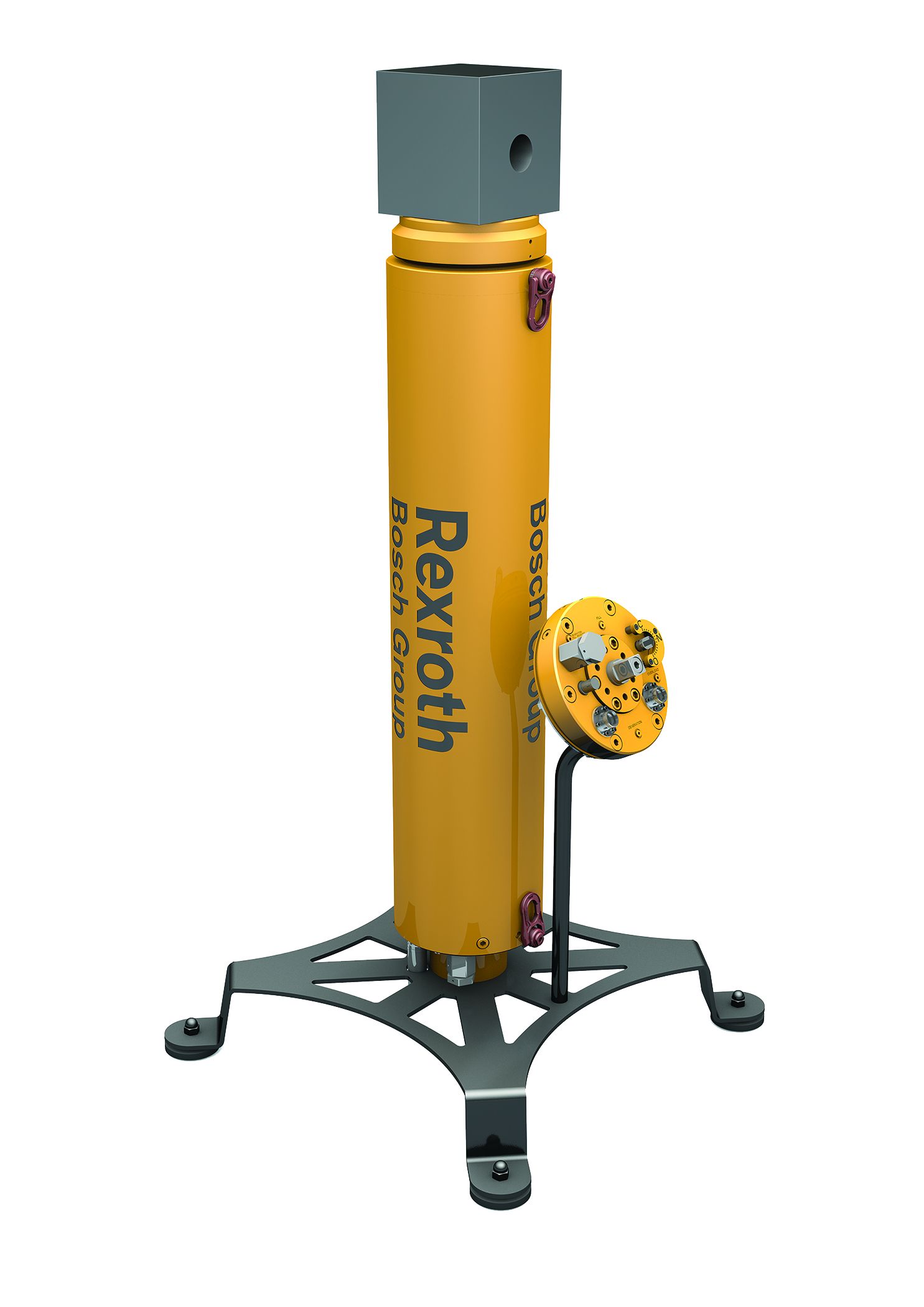
Considering all the actuators used to operate a subsea field, a huge cost saver for the electric infrastructure alone (power cable, transformer, frequency converters, etc.) can be obtained using hybrid SVAs versus using electromechanical actuators. (Source: Bosch Rexroth Corp., courtesy of DNV GL)
In oil and gas subsea production systems, each process valve is actuated by a subsea valve actuator (SVA) that must be able to safely close the valve in every operating state, even during power failure.
The requirements for subsea production systems are extremely high. Operational availability and safety are especially important for underwater systems for the protection of people and environments. Additionally, protecting the sea from pollution caused by the disposal of hydraulic fluid used in conventional SVAs is becoming a key priority.
A new concept for a hybrid SVA combines electromechanics and electrohydraulics, such as the operation of 2-in. gate valves. This hybrid type SVA is designed to meet safety requirements up to Safety Integrity Level 3, withstand an external pressure of up to 4,350 psi in a saltwater environment, consume up to 75% less energy and operate 24 hours per day over a 25-year lifetime with limited maintenance possibilities.
Self-contained axes with a hydrostatic drive
The recently developed SVA provides an energy-efficient and safe alternative to the previously used traditional hydraulic or electromechanical actuators that open and close the gate valve. Hybrid SVAs are self-contained modules with their own closed fluid circuit containing just a few liters of environmentally friendly hydraulic fluid. A variable-speed electric motor drives a durable hydraulic pump, which generates the flow required to actuate a hydraulic cylinder. The cylinder’s rod is mechanically coupled with the well’s gate valve stem to open or close
it as needed.
A safety valve with a mechanical spring inside the SVA ensures the cylinder also retracts safely into the fail-safe position if the power fails, without the need for external power supply or batteries. Additionally, the cylinder can be driven externally by an underwater robot via an override. All key components of the drive train are installed redundantly. Altogether, SVAs provide safety on different levels with the redundant controls, the fail-safe spring and the intervention options from outside.
The benefits of a hybrid SVA are evident when the solution is compared with the current state of actuator technology. The vast majority of underwater actuators used around the world are based on conventional hydraulics. This common structure has proven its durability and long-term safety over the past 50 years. However, operators want to reduce the effort needed to manage the well valve because conventional hydraulics typically require big, central hydraulic power units (HPU) on the topside. These supply the well valve actuators with fluid via umbilicals and jumpers that can be kilometers long. At a working depth of 3,000 m (9,842 ft), several hundred liters of fluid can accumulate in the lines alone. Furthermore, that conventional setup requires additional hydraulic accumulators and directional valves to control and command the actuation.

As an initial alternative, equipment suppliers tried to design purely electromechanical solutions. These only need to be supplied via power cables and connected via a data line to an actuator control module located either topside or on the seabed. However, because they have no options for external mechanical intervention for adjustments, electromechanical solutions have safety related disadvantages. And due to their lower power density versus hydraulic systems, they also require bigger housings and electrical batteries. The design results in high friction, causing mechanical wear on the power transmission and reducing the required 25-year operating period. For these reasons, electromechanical solutions are at a critical disadvantage for subsea applications when a fail-safe emergency closure is needed.
Less energy consumption
The hybrid SVA combines the benefits of both hydraulic and electromechanical solutions and eliminates the existing disadvantages. The decentralized self-contained fluid circuit means the topside HPU, subsea hydraulic control module and kilometer-long umbilical lines are no longer required for the fluid. The SVA only requires a power supply and a data line—as specified by the Subsea Instrumentation Interface Standardization—similar to the electromechanical actuators. During operation, a high-efficiency fixed displacement/variable rotating hydraulic pump generates flow to drive the low-friction cylinder. The hydraulic system is simplified because proportional valves are not required, which significantly increases energy efficiency. Compared with purely electromechanical actuators, SVAs consume up to 75% less power at peak performance.
Considering all the actuators used to operate a subsea field, a huge cost saver for the electric infrastructure alone (power cable, transformer, frequency converters, etc.) can be obtained versus using electromechanical actuators, for example. The electric motor driving the hydraulic pump can then be configured considerably smaller but with the same adjustment force of the actuators, which in turn saves installation space and costs. More cost savings can be realized from substituting the hydraulic umbilical with an electric umbilical, and there is no need to dispose of hydraulic fluid that is required for conventional hydraulic actuators.
The SVA also offers conditionmonitoring capabilities, with built-in sensor technology that continuously records the operating states within the actuator and reports them to the higher-level master controller. Trends can then be analyzed, allowing deviations to be identified and solved early.

Technology transfer
The operating principle for the SVA comes from the accepted use of self-contained axes often found in industrial applications. Individual components for the SVA are manufactured in large-scale series under quality management systems such as the ones used in industrial machines. This standardization reduces costs and creates long-term availability for production. In addition, the sensors and electronics used in the SVA have proven reliability from use in automotive vehicle applications. Where required, modifications have been made to the components to qualify for deepsea use at depths up to 6,000 m (19,685 ft). The system and core components also meet special requirements of the different classification societies for marine, offshore and subsea use.
Within the SVA, there is 29 psi of overpressure at every depth because of the redundant pressure compensation system. This prevents the penetration of saltwater and the need for large housings with a pressure- neutral design. In addition to the standard requirements, only subsea-rated wiring and connections are used within the axis. All electrical components that are not subsea rated are also mechanically and electrically encapsulated with pressure-resistant parts.
Working closely with equipment suppliers and operators, the latest simulation technology was used to create the proof of concept and prototypes for field trials. This drive technology combines the best of electromechanics and hydraulics to help ensure safe and reliable motion control on the seafloor, helping to bring the vision of an “all subsea factory” into reality.
Recommended Reading
Sunoco’s $7B Acquisition of NuStar Evades Further FTC Scrutiny
2024-04-09 - The waiting period under the Hart-Scott-Rodino Antitrust Improvements Act for Sunoco’s pending acquisition of NuStar Energy has expired, bringing the deal one step closer to completion.
NOV's AI, Edge Offerings Find Traction—Despite Crowded Field
2024-02-02 - NOV’s CEO Clay Williams is bullish on the company’s digital future, highlighting value-driven adoption of tech by customers.
From Restructuring to Reinvention, Weatherford Upbeat on Upcycle
2024-02-11 - Weatherford CEO Girish Saligram charts course for growth as the company looks to enter the third year of what appears to be a long upcycle.
President: Financial Debt for Mexico's Pemex Totaled $106.8B End of 2023
2024-02-21 - President Andres Manuel Lopez Obrador revealed the debt data in a chart from a presentation on Pemex at a government press conference.
Shell’s CEO Sawan Says Confidence in US LNG is Slipping
2024-02-05 - Issues related to Venture Global LNG’s contract commitments and U.S. President Joe Biden’s recent decision to pause approvals of new U.S. liquefaction plants have raised questions about the reliability of the American LNG sector, according to Shell CEO Wael Sawan.




